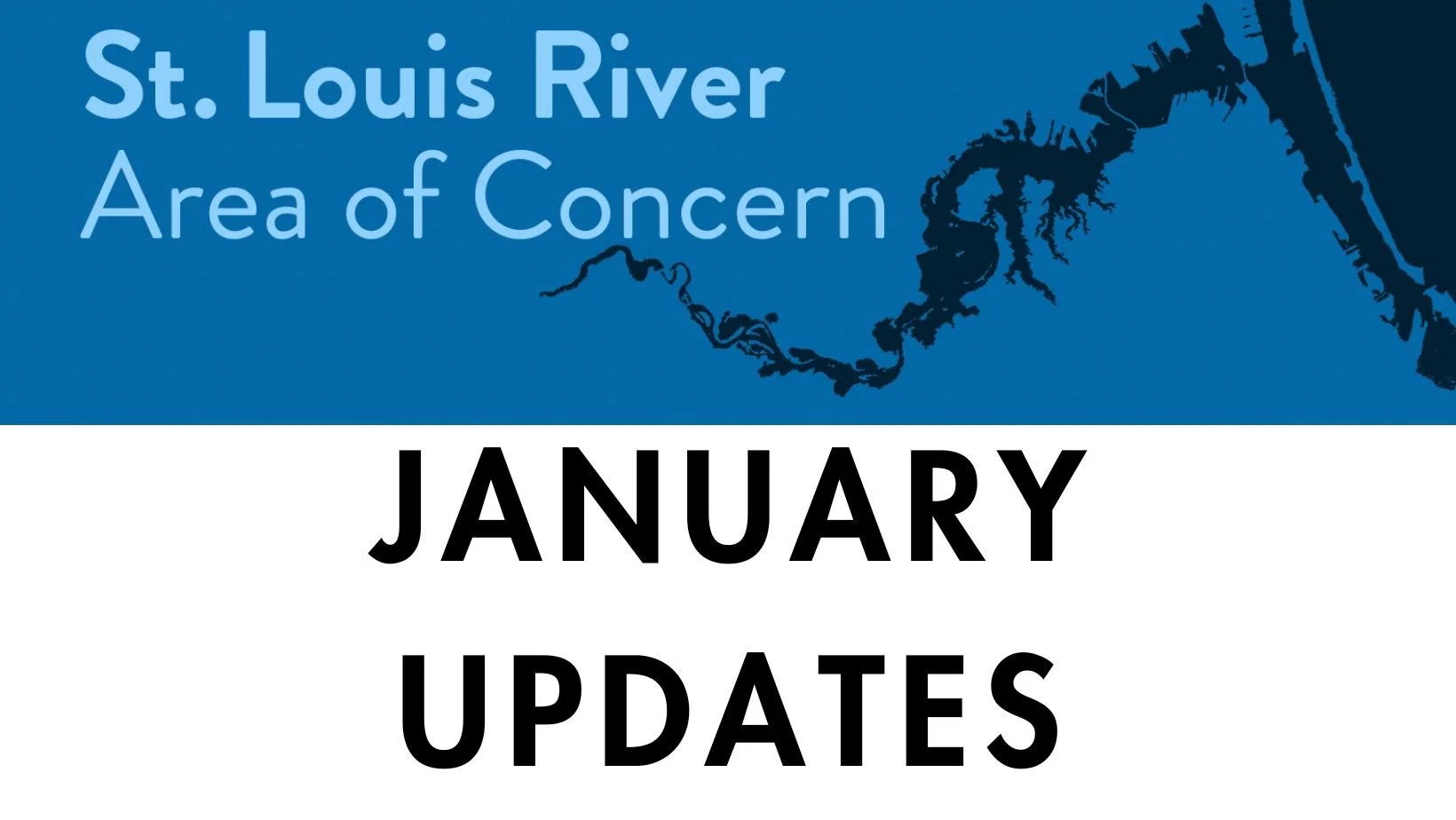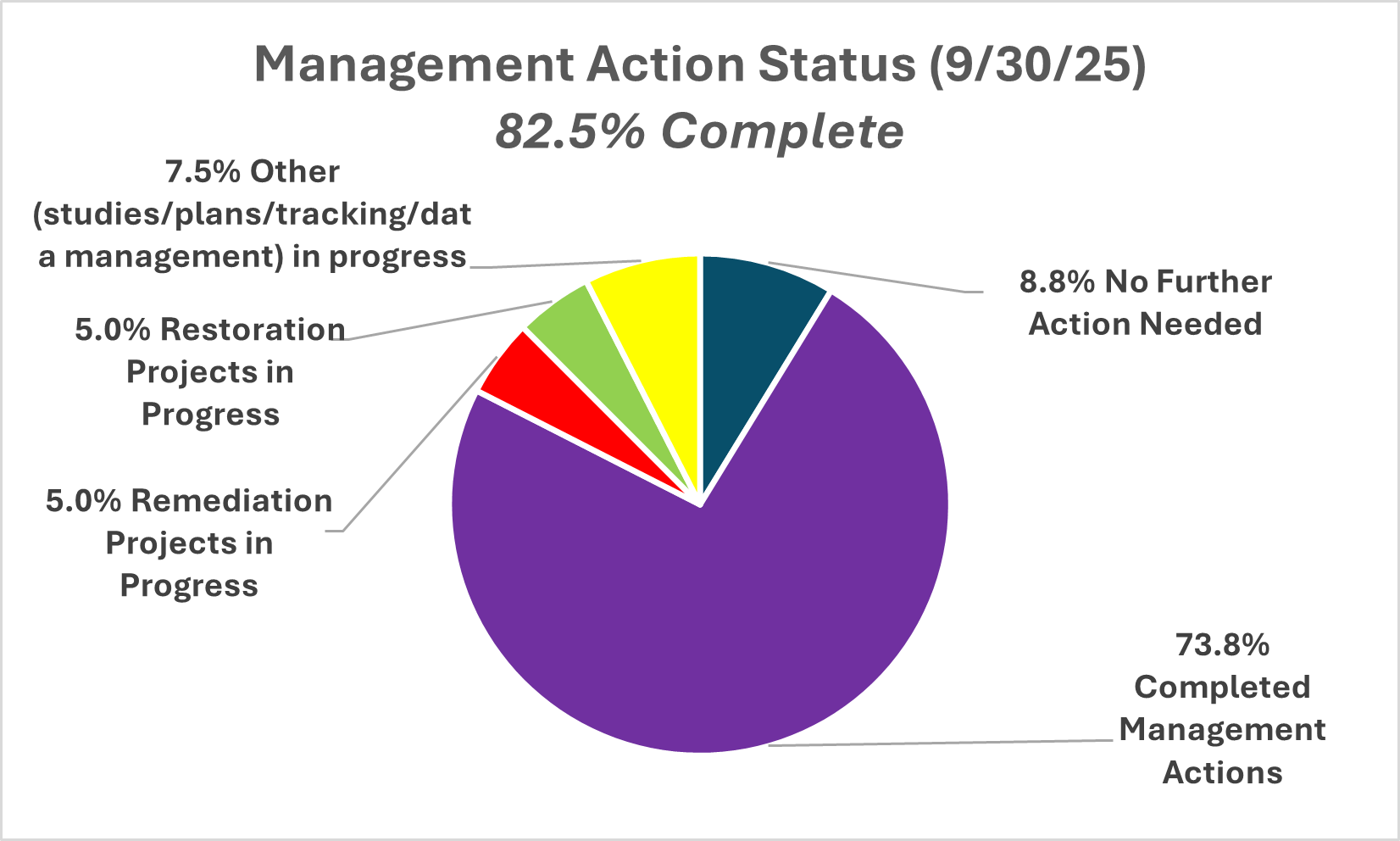St. Louis River Area of Concern
The St. Louis River was designated as one of the 31 U.S. Areas of Concern (AOC) on the Great Lakes due to significant historical issues with pollution and degraded habitat.
Watch the short video below, and continue reading to learn how the St. Louis River Alliance has partnered with agencies and community members to clean up the river.
News & Updates
The Program
The St. Louis River Area of Concern (SLRAOC) is one of 31 AOCs in the U.S. portion of the Great Lakes basin. It was designated as an AOC under the U.S. – Canada Great Lakes Water Quality Agreement in 1987 because of significant impacts that occurred before modern environmental laws were in place.
What is an AOC? WDNR explains it here.
The Place
The boundary of the SLRAOC encompasses parts of Minnesota and Wisconsin, but the restoration work is focused along the lower portion of the St. Louis River, from the Scanlon Reservoir near Cloquet all the way into the Twin Ports shipping harbor.
The St Louis River is the largest U.S. tributary to Lake Superior and one of two major rivers in the SLRAOC. It drains an area of 3,634 square miles, only a portion of which is in the SLRAOC, and it enters the southwestern corner of the lake between Duluth, Minnesota and Superior, Wisconsin. The river flows 192 miles through three distinct areas: coarse soils, glacial till and outwash deposits at its headwaters; a deep, narrow gorge at Jay Cooke State Park; and red clay deposits in its lower reaches. As it approaches Duluth and Superior, it becomes a wide, 12,000-acre freshwater estuary where the waters of Lake Superior and the river mix. The upper estuary has wilderness-like areas, while the lower estuary is characterized by urban development, an industrial harbor and a major port.
The Nemadji River drains 433 square miles. Approximately 60 percent of the watershed lies in Minnesota and 40 percent lies in Wisconsin. "Nemadji" is from the Ojibwe language, meaning left-hand river—when approached from the west end of Lake Superior, the mouth of the Nemadji was on the left; to the right was the estuary of the St. Louis. The Nemadji River bends and turns for approximately 65 miles in both Minnesota and Wisconsin, passing through highly erodible clay and sandy soils. The Nemadji River joins with the St. Louis River in Superior Bay and into Lake Superior through the Superior entry navigation channel.
The Issues
Nine Beneficial Use Impairments (BUIs) were identified as the environmental impacts that need to be addressed in the SLRAOC.
Fish consumption advisories
Degraded fish and wildlife populations (removed in 2023)
Fish tumors and deformities (removed 2019)
Degraded benthos
Restrictions on dredging
Excessive loading of nutrients and sediments (removed in 2020)
Beach closings and body contact
Degraded aesthetics (removed 2014)
Loss of fish and wildlife habitat
A Remedial Action Plan describes the removal targets for each BUI, the actions needed to reach those targets, and the anticipated schedule to complete those actions. Once all nine BUIs are removed, the SLRAOC can be delisted.
The People
Local, state, tribal, and federal agencies are working with citizens, non-profit organizations, universities, and business to move the SLRAOC from an “Area of Concern” to an “Area of Recovery”.
Four agencies are leading this effort:
Wisconsin Department of Natural Resources
Minnesota Pollution Control Agency
The St. Louis River Alliance has connected citizens to this work and provided a voice in this process since 1987. SLRA staff and members have been very active in helping reach the St. Louis River Area of Concern goals.
The St. Louis River Alliance has:
Helped develop the Remedial Action Plans that identified the BUIs and their removal targets, along with the actions needed to accomplish the targets
Prepared the Lower St. Louis River Habitat Plan that helped identify which habitat restoration projects would be included in the Remedial Action Plan
Led annual activities that connect people to the SLRAOC, as a program and as a place, so area residents and visitors can better understand the SLRAOC accomplishments
Monitored the endangered Piping Plover population and assisted with wild rice establishment and education efforts
Participated in monthly SLRAOC coordination meetings and on BUI technical teams
Advocated for BUI removals
Helped secure $25.4 million in Minnesota Bond Funds that will leverage $47.2 million in federal Great Lakes Restoration Initiative Funds for Minnesota’s contaminated sediment projects
Promoted continued federal appropriations to the Great Lakes Restoration Initiative Fund
The Projects
Most St. Louis River Area of Concern projects are constructed underwater, so it is hard to see what type of work is being done. A story map has been produced to share more detailed information about the construction projects.
Click on this hyperlink to learn more: https://storymaps.arcgis.com/collections/636bea98abfb425687bfb78fb34ca9a1.
Click the button below to learn what field work is anticipated in 2025 in Minnesota and Wisconsin.
The Progress
Every 6 months, a report of St. Louis River Area of Concern progress is sent to the U.S. Environmental Protection Agency (EPA). As of September 30, 2025, 66 of the 80 management actions have either been completed or determined that no further action is necessary. That means we are 82.5% of the way to being able to apply for delisting! This important work would not be underway without the support of the community members.
The Future
Even after the SLRAOC is delisted, there will still be environmental issues to address in the St. Louis and Nemadji River watersheds and in Lake Superior. Issues that developed after the onset of environmental laws will remain the responsibility of local, state, and federal agencies, but actions will need to be taken under other program authorities. There will always be a role for citizens to monitor conditions, provide input, and advocate for funding.
Resources
Click here to view the 2024 Remedial Action Plan.
For more details and resources from the U.S. Environmental Protection Agency, go to: https://www.epa.gov/great-lakes-aocs/st-louis-river-aoc.
To learn more about how science, ecosystems, and humans interact in the St Louis River Estuary from the people who live and work there, visit this website http://www.stlouisriverestuary.org/.
Duluth’s Revitalization: The St. Louis River AOC
Many Great Lakes communities have carried the burden of legacy pollution for decades. Now, they have a new lease on life as local waterways are cleaned up. Watch to see how the clean-up efforts in the St. Louis River Area of Concern (AOC) have led to growth in Duluth’s economic, recreational, and tourism industries. Watch Full Series
Restoring Wild Rice in the St. Louis River Estuary
Wild rice, or manoomin in Ojibwe, is a nutritional grain that is central to the cultural identity of the Ojibwe people. It's also an important ecological resource that's largely been lost in the St. Louis River estuary. This video shows how we are working with the Fond du Lac Band of Lake Superior Chippewa, the Great Lakes Indian Fish & Wildlife Commission and other partners to restore 275 self-sustaining acres in the AOC.
Protecting Dunes and Restoring Piping Plover Habitat on Wisconsin Point
Wisconsin Point is an important wildlife habitat, migratory bird stopover and historical site with great cultural significance. Sensitive dune habitats and historical sites are being protected, while also improving public beach access. Another project created 14 acres of new habitat for the endangered Piping Plover at the DNR-owned Wisconsin Point Bird Sanctuary.
Restoring Barker’s Island Beach in Superior
The beach at Barker's Island in the city of Superior now has cleaner water thanks to added native plants and improved access for people to enjoy the water through ecologically sound parking and beach upgrades. This project is part of the larger effort to restore the St. Louis River AOC.
2024 The St. Louis River: A Virtual Tour of Recreation Opportunities (PDF)
Presented by Melissa Sjolund, Minnesota Department of Natural Resources and Matthew Steiger, Wisconsin Department of Natural Resources. Click the link above to learn where you can recreate within the estuary, and the cleanup efforts that have made it possible.
2023 Area of Concern Updates Presentation (PDF)
Presented by Barb Huberty, Minnesota Pollution Control Agency, on behalf of the St. Louis River Area of Concern Coordinators









Stay safe and have fun on the winter river! Join us Feb. 7 at Munger Landing for ice safety lessons, snowshoe demos, a bonfire, hot cocoa, and updates on local restoration. Learn, explore, and enjoy the season.
Free and open to all. Register today!